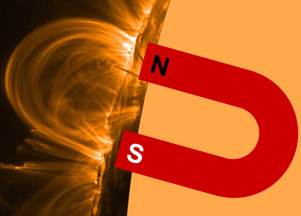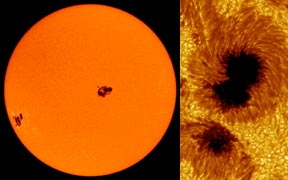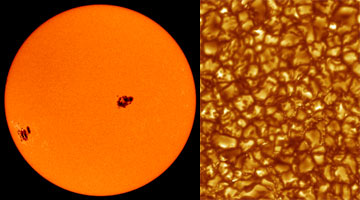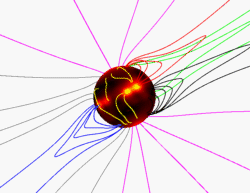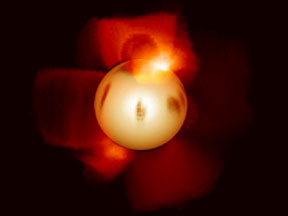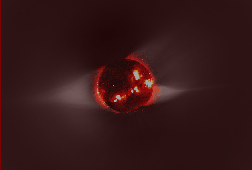Click on image for full size
Windows to the Universe original artwork by Randy Russell using an image from NASA's TRACE (Transition Region and Coronal Explorer) spacecraft.
Related links:
Movie: Journey Beneath a Sunspot
Movie: Magnetic Field Lines Tangle as Sun Rotates
Activity: Graphing Sunspot Cycles
Activity: Plotting Locations of Active Regions on the Sun
Activity: Tracking the Motion of an Active Sunspot Region
Movie: Supercomputer Models Help Scientists Understand Sunspots
Sunspots and Magnetic Fields
Sunspots are caused by extremely
strong, localized magnetic fields on the Sun. "Jet streams" of plasma
that form deep within the Sun's convective
zone produce powerful magnetic fields. When these loops of magnetism, or
magnetic "ropes", generated by flowing plasma break the visible surface
(photosphere) of the Sun, they produce sunspots.
Sunspots generally appear in
The intense magnetic fields at sunspots inhibit mixture of hot plasma from the surrounding photosphere into the sunspot regions. Sunspots are thus cooler, and therefore darker, than their surroundings. Magnetic field strengths within sunspots range from 1,000 to 4,000 Gauss, and are thousands of times more intense than Earth's average surface field strength of about 0.5 Gauss. The fields within sunspots are also much stronger than the Sun's global average field, which is around 1 Gauss. Larger sunspots have higher field strengths.
Although the details of sunspot formation are not thoroughly understood, scientists believe the differential rotation of the Sun is the underlying cause. Since the gaseous sphere of the Sun rotates more quickly at its equator than at its poles, the Sun's overall magnetic field becomes distorted and twisted over time. The twisted field lines eventually emerge through the photosphere, revealing their presence as sunspots.
Several major solar phenomena are associated with these twisted magnetic fields. When the tangled fields reach a "breaking point", like a rubber band that snaps when wound too tight, huge bursts of energy are released as the field lines reconnect. Such sudden shifts in magnetic fields generate energetic solar flares and vast Coronal Mass Ejections. The twisting of the Sun's global magnetic field also periodically causes the field to reverse its overall polarity, giving rise to the 11-year sunspot cycle and the 22-year solar cycle. Both the overall solar field, and the polarities of individual pairs of sunspots, "flip" on a periodic basis. Hale's Polarity Laws specify the polarity of each sunspot in a pair, which depends on the solar hemisphere in which the pair lies and on the phase of the solar cycle.


